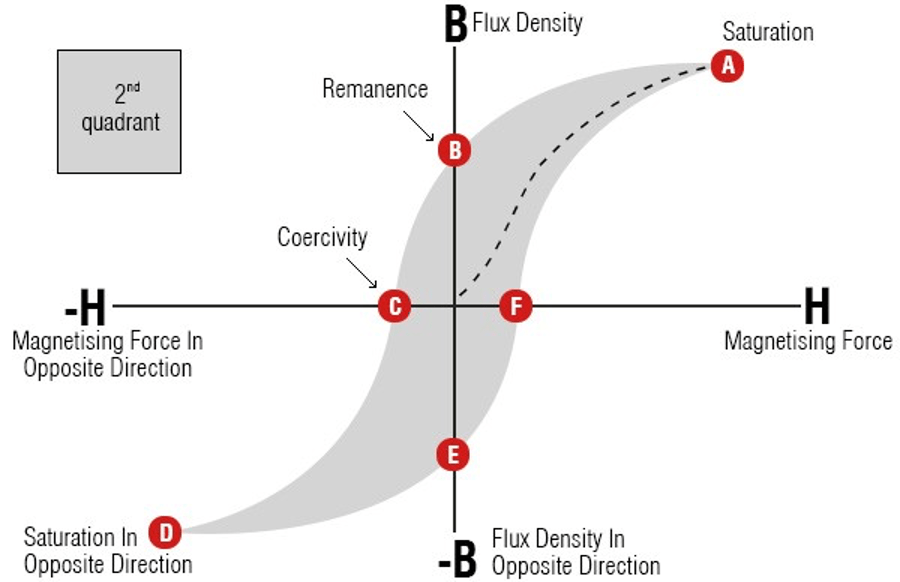What is Magnetic Coercivity?
When a magnetic material is exposed to an external magnetic field, it is compelled to become magnetised. It can also be demagnetised by an applied field.
Magnetic coercivity indicates how strong a field has to be to either magnetise or demagnetise a material. So, in other words, magnetic coercivity is the resistance of a material to magnetisation or demagnetisation. However, magnetic coercivity is more often referred to as the resistance of a material to demagnetisation because that gives us more insight into the magnetic properties of the material than its resistance to magnetisation.
Magnetic coercivity is measured by measuring the strength of an applied magnetic field (H) needed to bring the material’s magnetic field (B) to zero. It is measured in Oersteds (Oe), with 1 Oe being equivalent to 79.57747 A/m.
Magnetic coercivity is closely related to permeability, and understanding one property can make it easier to understand the other. Permeability is a material property which indicates how readily the material supports magnetic field development.
In this article, you will learn about:
- What magnetic coercivity is
- The measurement of magnetic coercivity
- Applications of magnetic coercivity
- Future materials and applications of magnetic coercivity
What is magnetic coercivity?
Materials can be broadly classified into soft magnetic materials and hard magnetic materials.
Soft magnetic materials can be easily magnetised and demagnetised. Hard magnetic materials are difficult to demagnetise once they’ve been magnetised.
Once the magnetising field is removed, a soft magnetic material would naturally start to lose its magnetism without any further action. Consider a typical hysteresis loop, as shown in Figure 1 below. Several properties can be visualised from the graph.
Magnetic coercivity (C) is the magnetising force (-H) that would be required to return the magnetisation of a material to zero after it had been previously magnetised to saturation.
Remanence (B) is the magnetism left in a material after the magnetising field has been removed.
Saturation (A, D) occurs when the magnetism reaches a maximum and cannot increase further even if the magnetising field is increased indefinitely.

Figure 1. Typical Hysteresis loop of a soft magnetic material [1].
Measurement of magnetic coercivity
Magnetic coercivity can be measured in several ways, including empirical measurements and numerical analysis. Magnetic properties, including magnetic coercivity, can be measured through the use of a digital permeameter [2]. It can also be measured through the analysis of the hysteresis loop of a material. The information to plot the loop is derived from software interpretation of data obtained from a device such as an oscilloscope [3]. There is also a measurement technique that involves recording the alternating electromotive force generated by vibrating a test sample in a search coil and the data computed through numerical analysis. The device used for this measurement is called a vibrating sample magnetometer [4].
Moreover, temperature has an effect on the magnetic properties of a material. So, it is important to specify the temperature in which a material is being evaluated as it may differ greater at different temperatures.
Applications of magnetic coercivity
When it comes to the applications, a number of magnetic properties have to be considered simultaneously along with coercivity. Chief among these properties is permeability, which is the magnetic material’s ability to form an internal magnetic field or to become magnetised when exposed to an applied magnetic field. A high-permeability material is easily magnetised when exposed to a magnetic field, and the opposite goes for a low-permeability material. It is not to be confused with the degree to which the material gets magnetised. It rather is the ease with which the material gets magnetised.
Coercivity is a lot lower for soft magnetic materials. Thus, they are better suited for applications where there is a rapid reversal in polarities. These include transformer cores and electric motors, where there are constant magnetisation and demagnetisation. The low coercivity of these materials reduces the losses during their operation significantly.
On the other hand, materials with high coercivity are required in situations where they need to retain their magnetism even when exposed to a magnetic field, as long as it is not strong enough to cause demagnetisation. Such materials would be referred to as hard magnetic materials or permanent magnets. They are used both for their ability to magnetise and their resistance to demagnetisation. Common examples of their application include speakers, hard drives, and electric generators.
Table 1. Magnetic properties of some magnetic materials.
| Material | Coercive force at 20oC | Intrinsic coercivity at 20oC | Remanence at 20oC |
| Alliance NdFeB N-40UH (Neodymium Iron Boron Alloy) |
938000 A/m | 199000 A/m | 1.26 - 1.32 T |
| Alliance Ferrite C-8 (Ferrite) |
239000 - 271000 A/m | 243000 - 275000 A/m | 0.38 - 0.41 T |
| Alliance SmCo5, SC-22 (Samarium Cobalt Alloy) |
676000 A/m | 1430000 A/m | 0.93 T |
| Alliance Alnico 5 (Aluminium Nickel Cobalt Iron Alloy) |
51000 A/m | 51000 A/m | 1.25 T |
| EFI Alloy 50 Square Bar (Nickel Alloy) |
4.77 A/m | NA | NA |
| Ferro-Titanit® S (Iron Matrix Composite) |
9800 A/m | NA | 0.11 T |
| Powercore® H 090-27 L (Steel) |
5 A/m | NA | NA |
| Tungsten (Tungsten) |
79.58 A/m | NA | NA |
Future materials and applications
The applications of magnetic coercivity cannot be dissociated from the applications of magnetism in general. The understanding of coercivity and the ability to manipulate it is, in essence, knowledge of the working condition limits of a material and the ability to increase or reduce it to suit specific applications. The thorough understanding of coercivity and other magnetic properties are leading to advancements in the following fields [5]:
- Data storage where higher storage capacities are required in smaller storage devices
- Ferrofluids
- Magnetic refrigeration
- Medicine in applications such as hypothermia, cancer therapy, etc.